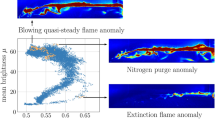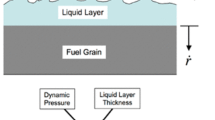Abstract
Clustering was applied to image data of hybrid rocket combustion tests for a better understanding of the complex flow phenomena. Novel techniques such as hybrid rockets that allow for cost reductions of space transport vehicles are of high importance in space flight. However, the combustion process in hybrid rocket engines is still a matter of ongoing research and not fully understood yet. Recently, combustion tests with different paraffin-based fuels have been performed at the German Aerospace Center (DLR). For a detailed analysis, the combustion process has been captured with a high-speed video camera, which leads to a huge amount of images for each test. In the end, a large data set with a total number of 30,000 images for each combustion test has to be analyzed. To catch the essential flow structures, the combustion data set was clustered with a K-means++ algorithm. Since the algorithm might converge to local optimal solutions, expensive repetitions have been performed to ensure that a global solution is found in the end. Furthermore, a detailed analysis was performed to find an adequate clustering algorithm in the first place and to estimate the number of relevant clusters K in each experiment. As a result, valuable insights into the different combustion phases were obtained and a comparison of the quality of the combustion flame in the different tests could be made. In particular, depending on the fuel formulation and oxidizer mass flow, differences in the transients and flame brightness were found.
Graphic abstract






















Similar content being viewed by others
Abbreviations
- \(C_i\) :
-
single cluster (−)
- I(x, y):
-
grayscale pixel intensity (−)
- J :
-
objective function (squared error) (−)
- K :
-
number of clusters (−)
- \(\varvec{x}_j\) :
-
data point j (a single image) (−)
- d :
-
problem dimension (resolution of \(\varvec{x}_j\)) (−)
- n :
-
number of data points in single test (−)
- \(s(\varvec{x}_j)\) :
-
silhouette value of the data point \(\varvec{x}_j\) (−)
- \(\bar{x}, \bar{y}\) :
-
image barycenter coordinates (−)
- f(K):
-
evaluation function to determine K (−)
- \(\alpha _k\) :
-
weight factor in f(K) (−)
- \(\varvec{\mu }_i\) :
-
mean of cluster \(C_i\) (centroid) (−)
References
Arthur D, Vassilvitskii S (2007) K-means++: The advantages of careful seeding. In: Proceedings of the eighteenth annual ACM-SIAM symposium on discrete algorithms, society for industrial and applied mathematics, Philadelphia, PA, USA, SODA 2007, pp 1027–1035. http://dl.acm.org/citation.cfm?id=1283383.1283494
Ciezki HK, Sender J, Clauß W, Feinauer A, Thumann A (2003) Combustion of solid-fuel slabs containing boron particles in step combustor. J Propul Power 19(6):1180–1191. https://doi.org/10.2514/2.6938
Devriendt K, Hook HV, Ceursters B, Petters J (1996) Kinetics of formation of chemiluminescent CH by the elementary reactions of C2H with O and O2: a pulse laser photolysis study. Chem Phys Lett 261:450–456
Ester M, Kriegel HP, Sander J, Xu X (1996) A density-based algorithm for discovering clusters a density-based algorithm for discovering clusters in large spatial databases with noise. In: Proceedings of the second international conference on knowledge discovery and data mining, AAAI Press, KDD’96, pp 226–231. http://dl.acm.org/citation.cfm?id=3001460.3001507
Hastie T, Tibshirani R, Friedman J (2009) Hierarchical clustering. Elements Stat Learn 2009:2
Jain A (2010) Data clustering: 50 years beyond k-means. Pattern Recogn Lett 31(8):651–666
Karabeyoglu A, Altman D, Cantwell BJ (2002) Combustion of liquefying hybrid propellants: part 1, general theory. J Propul Power 18(3):610–620. https://doi.org/10.2514/2.5975
Karabeyoglu A, Cantwell B, Altman D (2001) Development and testing of paraffin-based hybrid rocket fuels. In: 37th AIAA/ASME/SAE/ASEE Joint propulsion conference and exhibit, American Institute of Aeronautics and Astronautics, Salt Lake City, Utah. https://doi.org/10.2514/6.2001-4503
Karabeyoglu A, Stevens J, Geyzel D, Cantwell B, Micheletti D (2011) High performance hybrid upper stage motor. In: 47th AIAA/ASME/SAE/ASEE Joint propulsion conference and exhibit. American Institute of Aeronautics and Astronautics. https://doi.org/10.2514/6.2011-6025
Kobald M, Petrarolo A, Schlechtriem S (2015) Combustion visualization and characterization of liquefying hybrid rocket fuels. In: 51st AIAA/SAE/ASEE Joint propulsion conference. American Institute of Aeronautics and Astronautics. https://doi.org/10.2514/6.2015-4137
Krajsek K, Comito C, Götz M, Hagemeier B, Knechtges P, Siggel M (2018) The Helmholtz analytics toolkit (heat): a scientific big data library for hpc. In: Extreme data workshop 2018. https://elib.dlr.de/124422/
Lloyd S (1982) Least squares quantization in pcm. IEEE T Inform Theory 28(2):129–137
MacQueen J (1967) Some methods for classification and analysis of multivariate observations. In: Proceedings of the fifth berkeley symposium on mathematical statistics and probability, volume 1: statistics, University of California Press, Berkeley, Calif., pp 281–297. https://projecteuclid.org/euclid.bsmsp/1200512992
Ng AY, Jordan MI, Weiss Y (2001) On spectral clustering: analysis and an algorithm. Advances in neural information processing systems. MIT Press, Cambridge, pp 849–856
Pedregosa F, Varoquaux G, Gramfort A, Michel V, Thirion B, Grisel O, Blondel M, Prettenhofer P, Weiss R, Dubourg V, Vanderplas J, Passos A, Cournapeau D, Brucher M, Perrot M, Duchesnay E (2011) Scikit-learn: machine learning in Python. J Mach Learn Res 12:2825–2830
Petrarolo A, Kobald M (2016) Evaluation techniques for optical analysis of hybrid rocket propulsion. J Fluid Sci Technol 11(4):JFST0028–JFST0028. https://doi.org/10.1299/jfst.2016jfst0028
Petrarolo A, Kobald M (2018) Schlechtriem S (2018) Understanding Kelvin-Helmholtz instability in paraffin-based hybrid rocket fuels. Exp Fluids 59:62. https://doi.org/10.1007/s00348-018-2516-1
Pham D, Dimov S, Nguyen C (2005) Selection of k in k-means clustering. Proc Inst Mech Eng Part C J Mech Eng Sci 219(1):103–119
Rousseeuw P (1987) Silhouettes: a graphical aid to the interpretation and validation of cluster analysis. J Comput Appl Math 20:53–65
Schefer RW (1997) Flame sheet imaging using CH chemiluminescence. Combust Sci Technol 126(1–6):255–279. https://doi.org/10.1080/00102209708935676
Sculley D (2010) Web-scale k-means clustering. In: Proceedings of the 19th international conference on World wide web, ACM, pp 1177–1178
Thumann A, Ciezki HK (2002) Combustion of energetic materials, chap. Comparison of PIV and Colour-Schlieren measurements of the combusiton process of boron particle containing soild fuel slabs in a rearward facing step combustor, vol 5, Begell House Inc. https://doi.org/10.1615/IntJEnergeticMaterialsChemProp.v5.i1-6.770
Tibshirani R, Walther G, Hastie T (2001) Estimating the number of clusters in a data set via the gap statistic. J R Statist Soc B 63(2):411–423
Acknowledgements
This research was carried out under the project Antriebstechnologien und Komponenten für Trägersysteme (ATEK) by the German Aerospace Center (DLR).
Author information
Authors and Affiliations
Corresponding author
Additional information
Publisher's Note
Springer Nature remains neutral with regard to jurisdictional claims in published maps and institutional affiliations.
Rights and permissions
About this article
Cite this article
Rüttgers, A., Petrarolo, A. & Kobald, M. Clustering of paraffin-based hybrid rocket fuels combustion data. Exp Fluids 61, 4 (2020). https://doi.org/10.1007/s00348-019-2837-8
Received:
Revised:
Accepted:
Published:
DOI: https://doi.org/10.1007/s00348-019-2837-8




